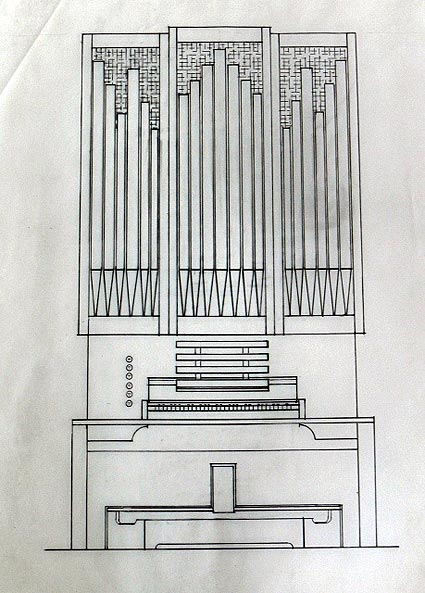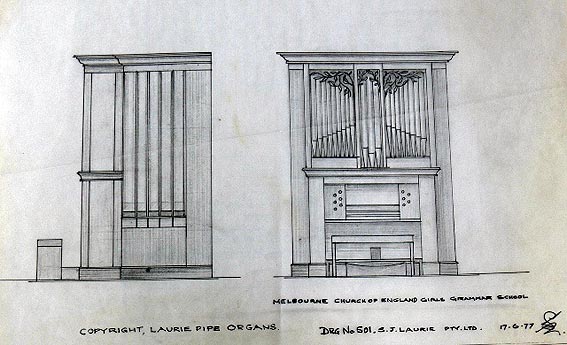From OHTA News April 2006:
Stephen James Laurie (1914 - 2006)

Steve Laurie, the prominent British-Australian organbuilder, died in Melbourne, Victoria on Friday 20 January 2006. He was in his 92nd year - a record only locally exceeded by South Australian organbuilder Josiah Dodd who passed away in 1952 at the age of 96.
Steve, who was a member of OHTA from the outset, was born in Harrow, London on 11 May 1914. He was apprenticed to the John Compton Organ Company Ltd at North Acton on 25 August 1931: this company was at the forefront of innovative organbuilding, with its liberal use of extension, well-crafted electric mechanisms, outstanding voicing and imaginative tonal design. Steve could not have been trained in a better environment - he learned a great deal that was later to bear successful fruit in his Australian work and worked on such famous instruments as Downside Abbey.
After eight years with Comptons, Steve moved on, eventually working with Pyrox, the prominent manufacturers of recording equipment. He and his family (wife Rosa and children Diana and John) arrived in Australia in 1948 to work for this firm. By 1952 he had been engaged by George Fincham & Sons to work for them on a part-time basis, but this soon became full-time. At the firm, he initiated new standards of construction, redesigning their electric actions utilising high-quality components, altering their tonal design and upgrading their voicing and pipe making. The large organ at Wilson Hall, within the University of Melbourne, was rebuilt under Steve's direction and exhibits several significant Compton ideas (Pedal Cornets, Choir Bombarde section).
After a few years he resigned from Finchams and started his own firm - Stephen Laurie & Company, his first workshop being the rear garage of his home in Dendy Street, Brighton. Soon, he gained his first contract for a new organ, at St Paul's Church, Euroa, and this was quickly followed by a succession of many new instruments, mostly built ingeniously upon the extension principle that he had learned at Comptons, and numerous rebuilds. His first factory was in Roberna Street, Moorabbin and later at White Street, Mordialloc, on the edge of the former racecourse.
The 1960s were a productive period for all Australian organbuilders, with expanding churches and congregations, and the funds to commission worthy pipe organs. Steve very much rose to this challenge and produced many smaller instruments of attractive appearance, careful tonal design and well crafted mechanisms, built at an affordable price. He was also aware of the classical revival and built a handful of smaller instruments with mechanical action, such as the outstanding instrument for Whitley College Chapel, Parkville, opened in 1975, while several pneumatic instruments were rebuilt with mechanical key actions. Time never stood still, and his tonal vocabulary expanded with such exotic delicacies as the Spitz Gamba, Pommer and Koppel Flute appearing in new instruments. Reeds were also voiced with increasing brightness and the sound in many instances changed from the full-blooded English-style harmonic Trumpets of Compton inspiration to a more harmonically rich French style.
Laurie Pipe Organs was also a fertile training ground for organbuilders and a number of organbuilders who later achieved prominence in their own right trained there. Steve was active in the foundation of the Australian Guild of Master Organ Builders - he sought the sharing of skills and knowledge with other firms and this continues to the present day.
Steve had a fertile mind and was quick to invent or develop new mechanisms. His 'SLIC' slider motors, dating from around 1970, were an innovative adaptation of the common automotive windscreen wiper motor and have been used worldwide. He also developed 'pouch' units for electro-pneumatic unit actions and these have not only been long-lived, but also offered excellent speech characteristics, unlike the direct electric actions which Steve generally avoided.
Steve was also amongst the first to carry out sensitive restorations. The first was probably the little Lemke organ from the Barossa Valley which was in St Peter's Church, Murrumbeena in the early 1960s before going down to Frankston. This was carefully refurbished and was a model for such work at the time. Later, Steve and his colleagues carried out significant work in many places, notably the Fincham organ at Armadale Baptist, the Joscelyne organ now at St James-the-Great, East St Kilda, the Bishop organ at St Andrew's, Carrick, Tasmania, and the Fincham & Hobday organ at the Uniting Church, South Melbourne, to mention just a handful of examples.
Steve's instruments are to be found in five Australian states, from south Brisbane to Hobart and to Adelaide, no mean record. They are installed not only in churches and cathedrals, but in private homes and one in a monastery. The largest new organ was that at St Andrew's, Brighton, opened in 1964, which at the time looked arresting and sounded splendid in such a resonant acoustic, now tragically ruined. Other prominent rebuilds included Caulfield Grammar School (1967 - destroyed by fire), Adelaide Town Hall (1970 - now being reconstructed), St Paul's Church, Geelong (1972), The Baptist Church, Collins Street, Melbourne (1976), St Mary's Cathedral, Hobart (1986) and Our Lady of Mount Carmel Church, Middle Park (1987).
He was a great supporter of the Melbourne International Festival of Organ and Harpsichord and in 1973 built a delightful small mechanical action organ for an exhibition at the National Gallery of Victoria. He also lent instruments for later exhibitions and was present at many of the concerts and post-concert festivities, enjoying meeting the performers and participants. Apart from his long-term membership of the Society of Organists (Victoria) and the Organ Historical Trust of Australia, he also enjoyed his membership of Rotary.
Steve was always an absolute gentleman in his dealings; he was most supportive of others and never hesitated to help when approached. His contribution to organbuilding in Australia in the post-war years has been highly significant - we are indeed fortunate that it was so well documented by Bob Jefferson in his 1999 work Steve Laurie, Organ Builder.
John Maidment
Please click here for an Excel spreadsheet of the technical drawings from Laurie Pipe Organs that have been deposited in the University of Melbourne Archives.
 |
 |
 |
Photo of Steve Laurie and three images of mechanical action organs that Steve Laurie tendered to build but didn't succeed in gaining the contract, supplied by John Maidment.